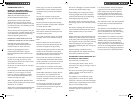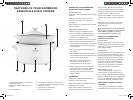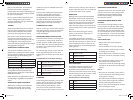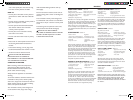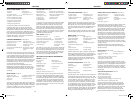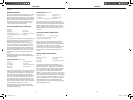
6 7
flavour, moist and tender. The Kambrook
Essentials Slow Cooker is designed to
produce these same results, whilst leaving you
the time to do other things, making it perfect
for today’s busy lifestyles.
Here is a guide to help simplify the process
of slow cooking, allowing you to obtain
maximum satisfaction from your Kambrook
Essentials Slow Cooker:
TIMING
Always allow sufficient time for the food to
cook. It is almost impossible to overcook
in the Kambrook Essentials Slow Cooker
particularly when using the Low Setting.
Most of the recipes contained within this
book can be cooked on the High or Low
settings, however the cooking times will vary
accordingly. Each recipe will give specific
instructions indicating the appropriate settings
and suggested cooking times.
ADAPTING COOKING TIMES
Your favourite traditional recipes can be
adapted easily by halving the amount of liquid
and increasing the cooking time considerably.
The following is a guide to adjusting your
favourite recipes:
Traditional Recipe Time Meal Maker Recipe Time
15-30 minutes 4-6 hours on Low Setting
60 minutes 6-8 hours on Low Setting
1-3 hours 8-12 hours on Low Setting
NOTE: High humidity, altitude, cold tap water
and ingredients and minor fluctuations may
slightly affect the cooking times in the Kambrook
Essentials Slow Cooker.
NOTE: These times are approximate. Times can
vary depending on ingredients and quantities in
recipes.
ADAPTING LIQUID AMOUNTS
When food is cooking in your Kambrook
Essentials Slow Cooker, most moisture
is retained. To allow for this when using
traditional recipes it is advisable to halve the
liquid content.
However, after cooking if the liquid quantity
is excessive, remove the lid and operate
the Kambrook Essentials Slow Cooker on
the High Setting for 30-45 minutes or until
the liquid reduces by the desired amount.
Alternatively, the liquid can be thickened by
adding a mixture of cornflour and water.
STIRRING THE FOOD
Little or no stirring is required when using the
Low Setting. However, stirring the food when
using the High setting ensures more even
flavour distribution.
PREPARING MEAT AND POULTRY
Select the leanest cuts when purchasing meat.
Trim the meat or poultry of any visible fat. If
possible, purchase chicken portions without
the skin. Otherwise, the slow cooking process
will result in extra liquid being formed from
the fat as it melts.
For casserole-type recipes, cut the meat into
cubes, approximately 2.5cm to 3cm. Slow
cooking allows less tender cuts of meat to be
used.
Suitable Meat Cuts for Slow Cooking
Beef
Beef Chuck, Skirt, Round Steak, Boneless Shin
(Gravy) Beef, Bone-In Shin (Osso Bucco).
Lamb
Lamb Shanks, Drumsticks (Frenched shanks)
Neck Chops, Best Neck Chops, Boned Out
Forequarter or Shoulder.
Veal
Diced Leg, Shoulder/Forequarter Chops and
Steaks, Neck Chops, Knuckle (Osso Bucco).
Pork
Leg Steaks, Diced Belly, Diced Shoulder,
Boneless Loin Chops.
BROWNING BEFORE SLOW
COOKING
Pre-browning meat and poultry, prior to slow
cooking, seals in the moisture, intensifies the
flavour and provides more tender results,
whilst producing richer flavours in other
food, such as onions, capsicums and leeks.
Pre-browning may take a little extra time, and
whilst not strictly necessary, the rewards are
evident in the end results. Use a non-stick pan
to reduce the amount of oil required.
ROASTING
Roasting meats in the Kambrook Essentials
Slow Cooker creates tender, flavoursome
results that are easy to slice. The long, slow,
covered cooking process breaks down and
softens the connective and muscle tissue
within the meat. Cheaper cuts of meat can be
used to provide perfect results cooked by this
method.
Meat will not brown during the roasting
process, so for browner results seal in a
frypan before roasting.
The addition of liquid is not required for
roasting. Elevate the meat to be roasted on an
inverted, heat proof saucer or plate. This will
assist in keeping the surface of the meat dry
and free from any fat released throughout the
cooking process.
Suitable Cuts for Roasting
Beef
Blade, Rump, Rib Roast, Sirloin, Fresh
Silverside, Topside.
Lamb
Leg, Mid Loin, Rack, Crown Roast, Shank,
Shoulder, Mini Roasts.
Veal
Leg, Loin, Rack, Shoulder/Forequarter.
Pork
Loin, Neck, Leg (remove skin and fat), Racks.
POT ROASTING
The addition of liquid is required for pot
roasting. Place sufficient liquid into the
Removable Crockery Bowl to cover up to a
third of the meat. Meat will not brown during
the pot roasting process. For browner results,
seal in a frypan before pot roasting.
Suitable Cuts for Pot Roasting
Beef
Beef Topside, Blade, Silverside Roasts, Rolled
Brisket.
Lamb
Forequarter, Shank, Shoulder
Veal
Shoulder/Forequarter.
Pork
Loin, Neck.
PREPARING VEGETABLES
Vegetables should be cut into small even-sized
pieces to ensure more even cooking. Frozen
vegetables must be thawed before adding
to other foods cooking in the Kambrook
Essentials Slow Cooker.
PREPARING DRIED BEANS AND
PULSES
If time permits, overnight soaking of dried
beans and pulses is preferable. After soaking,
drain and place in the Kambrook Essentials
Slow Cooker and cover with sufficient water
to reach double their volume. Cook beans on
the High Setting for 2-4 hours or until tender.
Pre-soaked beans and pulses will cook a little
faster.
HINTS AND TIPS
• Always thaw frozen meat and poultry
before cooking.
• Trim all visible fat from meat or poultry.
• Meat and poultry require at least 6-7 hours
of cooking on Low setting.
• Ensure that the food or liquid to be cooked
fills half or more of the removable crockery
bowl.
• On completion of cooking, if there is too
much liquid remove the lid, turn the
temperature control dial to the High setting
and cook for 35-40 minutes until the liquid
reduces.
DO’S
• Do ensure the removable crockery bowl is
at room temperature when placing into the
housing prior to cooking.
• Do avoid extreme temperature changes to
the crockery bowl and glass lid. Handle the
crockery bowl and glass lid with care.
• Do use oven mitts when lifting the crockery
bowl containing hot liquids.
• Do place the removable crockery bowl
KSC320.indd 6-7 10/5/07 9:51:48 AM




